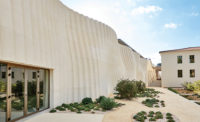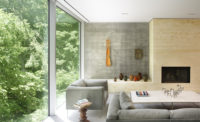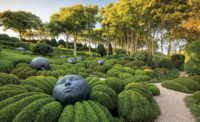The history of Provence—the region of southeastern France characterized by sun-soaked hills and a warm, dry climate tempered by salty ocean breezes—is steeped in winemaking. During the first century BC, upon discovering its fertile landscape and prime trading location, the Romans conquered the area, erecting numerous monuments, from arenas and temples to bridges and roadways, transforming it into a center of culture and wealth. In the small village of Taradeau, a new building for the more than century- old Domaines Ott winery, designed by Paris-based architect Carl Fredrik Svenstedt, hearkens back to this rich legacy. Its handsome limestone is extracted from the same quarry that gave rise to the Pont du Gard, an ancient Roman aqueduct 125 miles west.
The 45,000-square-foot building, which houses the vineyard’s production facilities as well as offices and visitor spaces, replaces the company’s previous early 20th-century building, which had a hodgepodge of additions. When Domaines Ott sold a majority stake in the business to Cristal purveyor Champagne Roederer in 2004, the opportunity to invest in a state-of-the-art premises arose. “They needed more space, and they wanted to really do it right,” says Svenstedt, “so they decided to start over completely.” The new building has about four times the winemaking capacity.
Additional Content:
Jump to credits & specifications
Working with Groupe Ducoin, a French engineering and design firm specializing in wineries, the clients invited three architects to submit plans for the new facility. Although the American-educated Svenstedt—who had done stints working for Santiago Calatrava and studioMilou before starting his own firm in 2000—had never designed a winery before, a member of the Ducoin team familiar with one of his residential projects (built from the same limestone, also located in the South of France) suggested to the client that Svenstedt be a part of the competition. Despite his lack of experience (“I was totally the underdog,” says the architect), Svenstedt’s scheme—a rectilinear form defined by an elegant latticed exterior—was chosen.
Sited on the edge of a meandering roadway and built into a hillside, the building was designed to appear as an “artificial horizon” in the landscape (much of the three-story structure is underground). Individual 2,205-pound blocks of stone were stacked to wrap around the building’s concrete framework. Toward the middle of the elongated volume, the self-supporting blocks overlap, preventing direct sunlight from entering the interior winemaking spaces, keeping them cool. At either end, the blocks are set at increasing distances from each other, providing daylight and visual access for an enclosed courtyard to the south, and offices and the visitors’ center to the north. In addition to being a practical feature, this masonry configuration also lends a dynamic quality. “I wanted to dissolve the scale so that you’re not looking at a big box,” says Svenstedt. “It has texture— the edges become like a filigree, making a very heavy material light.” To visually break down the structure’s mass for those driving along the roadway, the east facade is slightly curved.
Building with limestone also proved to be surprisingly economical: when Svenstedt first discovered chunks of the material being used for makeshift parking dividers in a nearby lot, he knew it couldn’t cost much. “Quarries are actually not doing very well, because people don’t build stone cities anymore,” the architect explains.
Up close, the discrete stone slabs provide a human scale for visitors approaching the building from the south parking lot; they enter the top level via a terrace that stretches along the facade’s length, overlooking the vineyard below and an 18th-century château, once home to the counts of Provence. “When you walk alongside the building, you have this sort of privileged relationship,” says Svenstedt. “There’s something very friendly about the pieces of stone—they encourage you to reach out and touch them.”
The terrace’s glazed entryway both reflects the landscape and allows visitors to peer into the main display area: a central, doubleheight space lined with wine casks. Inside, elevated walkways line the room, allowing for a closer look at the winemaking process. From the casks, the wine flows through pipes down to the lower level, where it is bottled and then shipped from the adjacent loading dock. The natural gravitational pull of the building’s sloped site aids this system, although stacking and arranging the interior spaces for optimum efficiency was no simple task; the architect consulted with Ducoin over the course of two years to get the layout just right.
The casks can also be viewed from above through a fully glazed wall in the tasting room. Throughout the public spaces, birch plywood ceilings contrast with exposed concrete floors. Birch is also used for furnishings designed by Svenstedt and for undulating wall panels that are both acoustic and decorative. The building’s transparent quality is extended to the office area, also on the top level, where workspaces are separated by floor-to-ceiling glazing. There the stone facade acts as a sunscreen, reducing the need for mechanical cooling.
For Svenstedt, whose diverse portfolio comprises residences and cultural and religious projects, as well as sports centers, the winery typology has provided a new architectural niche to explore—he is currently designing another in Ambonnay, in northern France. “The programmatic requirements for wineries are great, since there’s a real technical aspect, but, at the same time, it’s like a museum,” he says. “It’s the best of both worlds.”
CreditsArchitect: 5 rue Chapon
Personnel in architect's firm who should receive special credit: Carl Fredrik Svenstedt, Principal
Interior designer: Carl Fredrik Svenstedt Architects
Engineers: Beccamel Mallard
Consultants: Wine consultant and site supervision: Ducoin SAS
Photographer: Hervé Abbadie +33 613 61 0034 abbadie@noos.fr Dan Glasser +44 7958 913871 danglasser@familythree.com |
SpecificationsStructural System On-site concrete and prefab beams Manufacturer of any structural components unique to this project: Aluminium windows (Technal)
Exterior Cladding Masonry: Structural Pierre du Gard limestone blocks 100x100x50cm from the Pont du Gard
Roofing Built-up roofing: Insulation and self protecting gravelled weatherproofing
Windows Wood frame: Technal aluminium double glazing
Doors Metal doors: Insulated sliding and rolling doors by Hörrmann Wood doors: Wood doors and all carpentry by Hertrich
Interior Finishes Cabinetwork and custom woodwork: Wood ceilings and all carpentry by Hertrich
Furnishings Reception furniture: Tasting bar, tasting tables, and rocking chairs by Carl Fredrik Svenstedt
Lighting Downlights: Modular Exterior: Bega |















Post a comment to this article
Report Abusive Comment